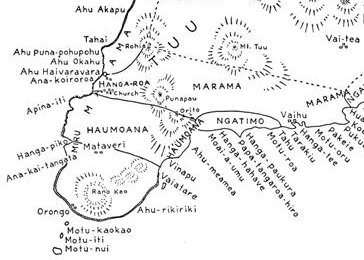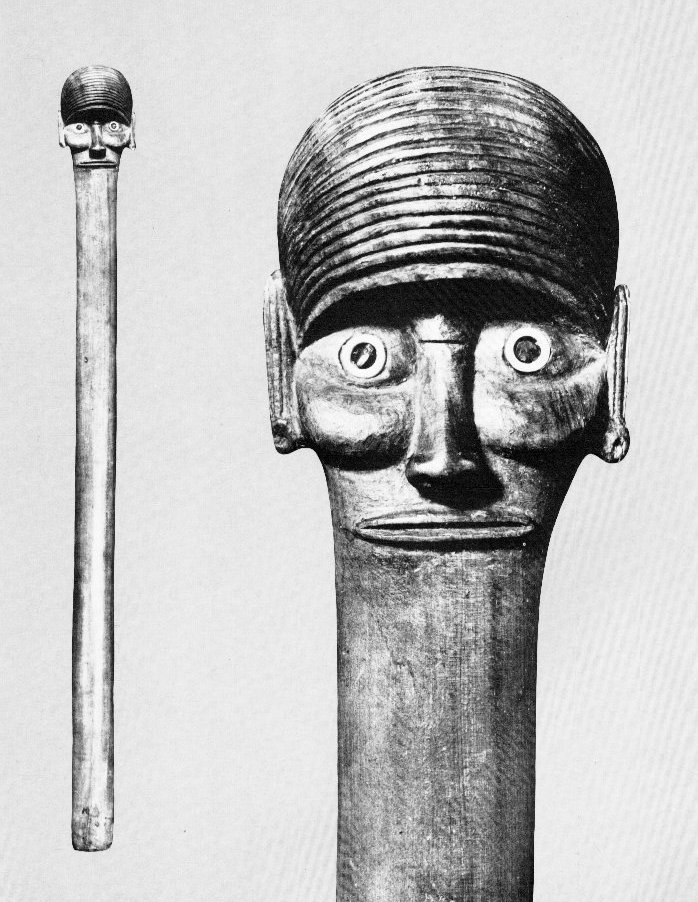The 2nd of the place names given by Makoi was Hanga o Uo:
|
38) |
|
1 |
ko apina iti.ko rapa kura.he oho mai he |
|
2 |
tuu ki hanga o uo.he nape i te ingoa.ko hanga o uo |
|
|
a vave renga. |
|
|
he nape he oho a Makoi .i te ingoa.ka vari ro. |
|
|
a arurua.aro i apina nui i hakatuu ai |
|
|
te maea.etahi no raa.i nape i oho ai. |
|
3 |
hanga roa a tuki tukau |
|
4 |
Okahu a uka ui hetuu. |
|
5 |
ra tahai a uo. |
|
6 |
ahu akapu a mata kurakura. |
|
7 |
kihikihi rau mea a rapa rau renga |
|
8 |
renga a tini a toto renga |
|
9 |
vai a mei u(h)i kapokapo. |
|
10 |
rua a ngau a nua ngirongiro. |
|
11 |
roro hau a mana ai rea. |
|
12 |
vai poko aa raa mata turu |
|
13 |
ko te hereke a kino ariki |
I tried to upgrade this information in a table:
|
1 |
Apina Iti |
4 |
Okahu |
|
2 |
Hanga O Uo |
5 |
Ra Tahai |
|
3 |
Hanga Roa |
6 |
Ahu Akapu |
|
|
7 |
Kihikihi Rau Mea |
|
8 |
Renga A Tini |
|
9 |
Vai A Mei |
|
10 |
Rua A Ngau |
|
11 |
Roro Hau |
|
12 |
Vai Poko |
|
13 |
Te Hereke |
Barthel says the correct name of the bay a short distance north of Apina Iti was Hanga O Ua.

This bay is not on the map of Métraux, but it ought to be between Apina-iti and Hanga-Roa, perhaps in the vicinity of the Church. Christian Churches usually were erected where other old beliefs were deeply rooted.
In time this place should come after Vero I thought. Could Hanga o Uo correspond to the 11th Marquesan month Uaoa?
| Rua
1. Two; second; other (precedes the noun); te rua paiga, the other side. 2. Hole, grave; holes in the rocks or between the rocks of the coastal lagoons; he keri i te rua, to dig a hole. 3. To vomit. Vanaga.
1. Two. P Mgv., Ta.: rua, id. Mq.: úa. 2. Nausea, seasickness, to vomit, disgust; hakarua, to vomit, to spew. PS Mgv.: aruai, ruai, to vomit. Mq.: úa, id. Ta.: ruai, id. Pau.: ruaki, id. Sa.: lua'i, to spit out of the mouth; lulua, to vomit. To.: lua to vomit. Fu.: lulua, luaki, id. Niuē: lua, id. Viti: lua, id.; loloa, seasick. 3. Cave, hollow, ditch, pit, hole, beaten path, grave; rua papaka, a ditch. P Pau.: rua, a hole. Mgv.: rua, a hole in the ground, ditch, trench. Mq.: úa, dish, hole, cavern. Ta.: rua, hole, opening, ditch. Churchill.
Ta.: ruahine, an old woman. Ma.: ruahine, id. Ta.: ruaroa, tropic of Capricorn. Mq.: uaoa, a constellation, the eleventh month. The sense in Tahiti is probably that of some constellation which may be used to determine the position. Ta.: ruau, an old man, an old woman. Ha.: luau, a parent. Churchill. |
I guessed Uaoa possibly could mean Ua Roa ('great rain' ?). The Marquesan dialect tends to manage without 'r', as for instance in Veo. But then Marquesan Uaoa could perhaps rather be Rua Roa, which Churchill evidently also had realized. And then we could alternatively see Uaoa as the tropic of Capricorn.
Maybe we should read the 3 first Makoi names as a unity. Triangulum Minus (Apina Iti) followed by Hanga o Ou a Vave Renga and Hanga Roa.
The change from Ua to Uo which Barthel suggests, could be a way to hide the correct meaning from ignorants and those of the Christian faith.
| Ua 1. Cause, reason why something happens or is done; he ûa te ua, au i-ta'e-iri-ai ki tooku hare, because of the rain, I did not go home; ua kore, without cause, without reason. 2. Ceremononial stave with a human face carved at one extremity. Vanaga. Cfr toko.
1. A long club T. 2. Mgv.: ua, the genitalia. Ta.: hua, id. Mq.: hua, id. Ha.: hua, testicles. 3. Ta.: ua, the back of the neck. Ma.: ua, id. Sa.: ua, the neck. 4. Ta.: ua, a land crab which shears iron. Ma.: uka, lobster. Sa.: uga, the hermit crab. Churchill.
Ûa. Rain; 1. ûa hakamito, persistent, but not strong, rain; 2. ûa kura, fine rain, drizzle; 3. ûa matavaravara, strong rain; 4. ûa parera, torrential rain; 5. ûa tai, rain followed by fair weather at sea. Ehu ûa, drizzle. Vanaga.
Ûaûa. Tendons, muscles. 1. Hau ûaûa kio'e, line made from rats' tendons. 2. Ûaûa toto, vein, artery. 3. Ûaûa piki, spasm. Vanaga.
1. Rain; hoa mai te ua, to rain; mou te ua, to cease raining. P Mgv., Mq., Ta.: ua, rain. 2. Vein, artery, tendon (huahua 1) (uha G); ua nene, pulse; ua nohototo, artery, ua gaei, pulse. Uaua, vein, tendon, line; kiko uaua, muscle T. Hakauaua, to mark with lines. P Pau.: tare-ua, tendon. Mgv., Mq., Ta.: uaua, vein, tendon. Churchill.
U'a. Of the tide, to reach its maximum; tai u'a, high tide. Vanaga.
Wave, surge; tai ua, high tide. Churchill.
Uá. Ata uá, morning twilight. Uáuá, to reside; resident; noho uáuá to settle somewhere; ina koe ekó noho uáuá, do not establish yourself there. Vanaga. |
|
Vave Water in motion, a long wave; pokopoko vave,
trough of the sea; tai vave, rough sea; vave kai kohe,
unapproachable. Churchill.
Pau.: A fringing reef. Mgv.: taivave, a
rolling billow. Ta.: vavea, a towering billow. Churchill. |
|
Rega Ancient word, apparently meaning 'pretty,
beautiful'. It seems to have been used also to mean 'girl' judging
from the nicknames given young women: rega hopu-hopu. girl
fond of bathing; rega maruaki, hungry girl; rega úraúra,
crimson-faced girl. Vanaga.
Pau.: rega, ginger. Mgv.: rega,
turmeric. Ta.: rea, id. Mq.: ena, id. Sa.: lega,
id. Ma.: renga, pollen of bulrushes. Churchill. |

|
The double-headed ua is variously described as a ceremonial staff occasionally employed as a fighting weapon, or as a long double-handled club normally carried as a badge of rank. Either interpretation is probably correct. A number of authentic pieces have been preserved and many more have been carved in post-missionary times primarily, however, from imported wood.
Whereas the slightly oval neck section of the staff is almost circular, its shorter diameter decreases and its longer increases towards the lower end, giving the staff a spatular shape. Sometimes, however, according to the suitability of the wood, the staff has a uniform cross section all the way down and the representation is bilaterally symmetrical. Eyes are inlaid as on the wooden images with bone rings enclosing obsidian disks. Strongly projecting pouches hang down below the eyes on each side of a long, straight and slim nose with naturalistic alae. The flat, elliptical mouth is carved with raised lips surrounding a horizontal groove. Teeth are not indicated. Long, narrow ears with earplugs are carved as bands along the edges. The forehead slants forward to project beyond the eyes. Eyebrows are lacking, but the wide and tall forehead is traversed horizontally by a dense series of grooves arching from one side to the other. There is no chin or beard, as the narrow lower face continues uninterruptedly into the staff. Specimens vary considerably in length, recent pieces sometimes approaching 6 ft. (nearly 2 m.), whereas ancient specimens are rarely more than some 40 ins. (ca. 1,20 m.) and sometimes slightly curved due to the imperfections of the toromiro available. Knots or other holes in the wood are often filled with perfectly fitted plugs. Ua were in some instances preserved in sheaths made from totora reed. (Heyerdahl 3) |
|

